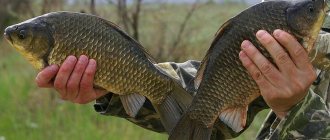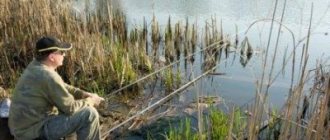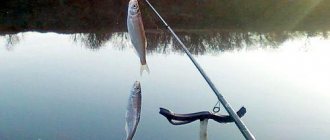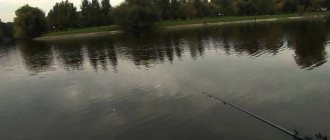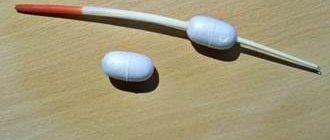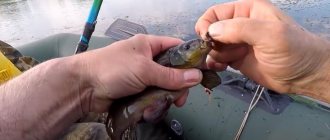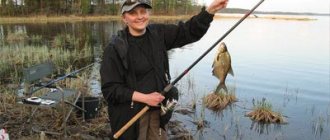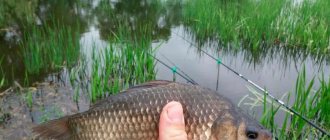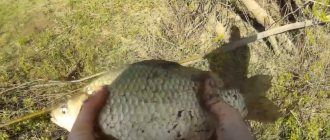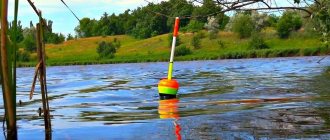This fish is found in rivers flowing into the Azov, Black, Baltic and Caspian seas. It prefers to develop large rivers and reservoirs, while completely ignoring small bodies of water, especially if they have thickets of aquatic vegetation.
Chekhon can grow up to 60 cm in length, weighing about 2 kg. As a rule, fishermen come across individuals weighing from 200 to 500 grams. The lifespan of this fish is about 12 years. Chekhon has a long, purlin-like shape, similar to a saber. Therefore, it is almost impossible to confuse it with another fish. As for the color, it has a silver tint, although dark colors predominate on the back. It has a fairly short dorsal fin, which is located above the anal fin. If during fishing you catch a similar fish, then it is undoubtedly a sabrefish. Her capture requires a special approach, which will be discussed in this text.
Where to catch saberfish
This fish prefers to be in that part of the water area where there is a fast current and great depth. During the day, when the saberfish feeds, it moves along different horizons and can be found near the surface of the water. With the onset of dusk, it goes deeper and only the next morning it begins to rise again closer to the surface.
The sabrefish spawns in May. Depending on the weather conditions or climate zone, these dates may shift in one direction or another. The beginning of spawning is characterized by the rise of sabrefish to the upper reaches of the river. At the same time, it can actively peck at various baits. This fish goes to spawn in schools, so you can catch several individuals at once. If sabrefish are no longer caught, it means that the flock has left and you need to wait for the next cluster of sabrefish to arrive.
The movement of sabrefish to spawn has its own peculiarity. It moves only through the deepest parts of the reservoir. At the same time, it does not approach the shore, especially during the daytime.
Each school contains individuals of the same size, so the catch is characterized by fish of the same size. Although mixed flocks can be found, this is very rare. After laying eggs, this interesting fish returns to its original place. Chekhon should be looked for:
- near deep holes;
- on the border of slow and fast currents;
- in deep waters;
- in areas with fast currents;
- in areas of rifts and underwater spits;
- in large bays free of vegetation.
The saber fish are caught in the upper or middle layers of water. This means that sabrefish are not caught from the bottom and some equipment used for catching other types of fish from the bottom is not suitable for catching sabrefish. At the same time, it prefers to stay in clean areas without aquatic vegetation that have significant depth. You will never find her in the shallows.
After spawning, saberfish return to permanent habitats, where they constantly move around the water area. At the same time, she does not stray far from her favorite places.
If a sabrefish bite occurs, it means the fish is in the area of this place and the probability of subsequent bites is quite high. This fact can serve as a guide to a promising location and in the future you can count on a good catch.
Chekhon does not like to come close to the shore, so catching it will require long casts.
There is no point in catching saberfish at night, since it sinks to depths or hides in safe places.
They catch saberfish mainly using bottom gear, which uses leashes up to 2 meters long. It is desirable that the nozzle has good buoyancy and can be in the water column without sinking to the bottom. If you place a foam ball on the hook along with the bait, the result will not take long to come. The sabrefish grabs the bait as it slowly sinks to the bottom. You don’t have to use polystyrene foam, then the hook with bait will reach the bottom and then bites from other fish, such as roach, silver bream, bream, etc., are possible.
Catching sabrefish with bottom tackle
In summer, simultaneously with sunset, saberfish leave the upper layers and rush closer to the bottom, where they continue to feed. You can successfully catch sabrefish even in the coastal zone, but provided that the depth at the selected point exceeds two meters. For fishing, an 8-meter match rod is used, which is equipped with a luminous float.
The load is selected based on the strength of the current. In order to maintain the sensitivity of the tackle, several small pellets are installed on the fishing line with an interval of 25 cm between them. The bites of sabrefish in the dark continue until approximately 12 o'clock at night, after which there is a lull. Fish activity resumes before flowering. You can catch sabrefish from the bottom during the day, but only if the weather is cloudy and the daily air temperature drops.
Dung worms, maggots, and aquatic insect larvae are used as bait. It is always possible to attract sabrefish to the fishing site by using bait, the main composition of which necessarily includes a small part of the bait used.
An excellent option for feeding a place is to use clay, into which scalded maggot or chopped worm is mixed. Balls are made from the resulting mixture and lowered into the water a few meters from the fishing point. Gradually, the clay balls will be eroded by the current, due to which pieces of food will fall out of them. The smell of a chopped worm can attract saberfish from any corner of the pond.
When to catch sabrefish
The sabrefish shows its maximum activity during the pre-spawning period. Somewhere from mid-April and for 3 weeks, this fish prepares to spawn. The preparation consists of gaining strength after the wintering period. During this period, it is actively caught, as it is ready to swallow any bait. Considering the fact that saberfish gather in dense flocks, there is a possibility of catching a dozen specimens in a very short period of time. After this, the biting may stop altogether until the next flock approaches. When the sabrefish is busy with the process of spawning, it stops feeding altogether. The activity of this fish resumes after spawning, when it recovers from illness and returns to its favorite places.
In fact, saberfish begin to be caught from the moment the water surface is freed from ice and its active biting continues until the first ice appears on the surface of the water. In mid-summer, with the advent of heat, sabrefish bite better from early morning and before 10 am, as well as from 6 pm until dusk.
After the heat leaves and the cold arrives, it bites better before lunch, when the upper layers of the water warm up well.
In winter, this fish is practically not caught, although some anglers manage to catch saberfish from the ice in winter. Unfortunately, this requires serious knowledge, experience and skills.
What should you use to catch saberfish?
We can say that sabrefish is an omnivorous fish and yet it prefers baits of animal origin. It could be:
- muckworm;
- bloodworm;
- maggot;
- live bait;
- grasshopper;
- fly;
- dragonfly;
- butterfly;
- wasp;
- gadfly, etc.
As practice shows, saberfish are especially partial to maggots. A combination of maggot and bloodworm works well. Therefore, when going fishing with the aim of catching sabrefish, you should have the main bait with you - maggots.
As a rule, several, from 2 to 5 maggots, are attached to the hook. Moreover, the best option may be a combination of maggots of different colors. Shades of white and red or white and yellow work well. Nowadays it’s not a problem to purchase multi-colored maggots at specialized retail outlets or to grow them yourself if you wish. You should not get too carried away with colors and two colors are absolutely enough.
Chekhon prefers to take bait suspended in the water column. Therefore, in addition to bait, it is better to attach a foam ball to the hook. In this case, the foam is attached first, and then the bait. As a rule, in such cases, hooks with a long shank are used so that all the necessary elements fit on it.
When using live bait, large sabrefish are caught more often, although the size of the live bait should not exceed 4 cm. Still, sabrefish cannot be larger than pike, so it makes no sense to use larger fry.
In the summer, when there is an abundance of various insects in nature, saberfish are excellently caught on them. These could be butterflies, wasps, various bugs, grasshoppers, etc.
Various tackles, such as a feeder, a float rod or a spinning rod, are suitable as a tool for catching sabrefish. The saber fish are caught both stationary and in the wiring.
Features of gear construction
Catching sabrefish on a feeder has its own characteristics in the construction of gear. Here are some of these features:
- Feeder fishing involves casting over long distances. Therefore, it is better to take an elongated rod, about 3.5-4 meters. Read more about his choice here.
- The reel should be of medium size. In order for the line to recoil better, the clutch on the reel is loosened.
- The diameter of the main line should be 0.13 or 0.14 millimeters, but not less. This is explained by the fact that the thickness of the fishing line affects the casting distance.
- The leash should be long, from 1 to 2 meters. This is necessary so that the force of the current lifts the leash from the bottom. Thus, the hook with bait will not be on the bottom, but in the sabrefish’s habitat – the middle thickness of the water. The leash line must be used with a larger cross-section than the main line. Its diameter should be 0.16-0.18 millimeters.
- When building feeder gear, the feeder is especially important. To make it faster and more convenient to change one feeder to another, it is attached to a special carabiner (American). The weight and size of the feeder should be selected based on the characteristics of the reservoir in which fishing will take place. In rivers with strong currents, heavy feeders are used to prevent them from being carried away by the current. And for fishing sabrefish in calm water, it is better to use a light feeder so that it sinks to the bottom as long as possible.
- Hooks for catching sabrefish on the feeder are used No. 12, No. 13 or No. 14. It is better to choose hooks whose point is slightly bent inward. To make the hook buoyant, put a small piece of foam on it, and then attach the bait.
Photo 1. Feeder for river fishing.
Catching sabrefish using a spinning rod
Spinning has long been associated with universal fishing gear, although its main purpose is to catch predatory fish. The saberfish can also be classified as a predatory fish, since it quite often feeds on small fish. A variety of artificial baits can be used to catch saberfish. It can be:
- vibrotails;
- wobblers;
- twisters;
- various baits made of edible rubber;
- flies.
Good results can be expected when using vibrating tails. At the same time, large sabrefish are caught more often with such baits. This is due to the fact that small saberfish still do not chase fry much, preferring to feed on various insects or bugs.
When fishing for saberfish, use the usual stepped fishing. Baits are cast both with the current and against it. If the fish is interested in the bait, the bite will follow immediately. At the same time, it should be remembered that sabrefish are mainly dispersed in the middle and upper layers of water.
Assembling a spinning rod
Since small, lightweight baits are usually used when fishing for sabrefish, in most situations a light or ultra-light class .
Rod
For fishing from the shore , when long casting is required, a rod with a length of at least 2.7 m is well suited. When fishing from a boat, a spinning rod up to 2.4 m is sufficient.
Coil
When catching sabrefish using a spinning rod, it is necessary to use a spinning reel , which makes it possible to make long-distance casts of light baits. Its size is selected based on the power of the fishing rod used, the thickness of the fishing line and the weight of the bait.
fishing line
You can use thin (no more than 0.1 mm) braid or monofilament with a diameter of 0.15 - 0.25 mm. Using a braided cord allows you to achieve better control over the bait and maximum sensitivity of the gear.
Due to its stretchability, monofilament absorbs fish jerks well, which can help when fishing for a trophy, especially if you are using a budget rod and reel with an insufficiently reliable friction brake.
How to catch saberfish
When fishing for this fish, the following basic gear is used:
- bottom fishing rod (feeder);
- float rod;
- spinning.
You can catch saberfish in other ways, for example, fly fishing or using a bombard (sbirulino). Unfortunately, such fishing techniques require serious skills and are therefore rarely used. Despite this, such gear has maximum catchability, especially the bombard.
The most affordable and effective way to catch saberfish is with bottom tackle or a feeder. This gear will be discussed further.
Feeder fishing technique
Once a suitable place for catching sabrefish has been selected, you can begin feeding the fishing point. To do this, the first 5-10 casts are made without a leash, but with a feeder filled with bait. To begin with, you can take a larger feeder to feed the area faster. In this case, 5 casts will be enough.
After this, the feeder is changed to a regular one and a leash with a hook is added to the equipment. The bait is placed on the hook, and groundbait is filled into the feeder. The length of the leash for sabrefish can reach up to 1.5-2.0 meters. Naturally, this complicates the process of casting the tackle, but catching sabrefish is guaranteed. With a leash length of less than 1.5 meters, in addition to sabrefish, other fish can be caught, such as roach, rudd, silver bream, etc.
The consistency of the bait is selected so that it is washed out of the feeder in no more than 5 minutes. Every 5 minutes you should check the tackle if there are no bites. If there are no bites for a long time, then this is most likely the result of an incorrect choice of fishing location. After all, this fish prefers specific places with good depth. If the depth is insignificant, then it is unlikely that saberfish can be found in this place.
Fishing technique with float tackle
Considering the behavior of this fish, it is better to catch it in a retrieve. In this case, the tackle is thrown in and sent downstream. At this point, the line is gradually released from the reel. At the same time, you need to be prepared for a bite, which can happen at any moment.
With ordinary, classic fishing with a float, it is necessary to regularly set the bait in motion, since saberfish attack bait that is in motion. As soon as the fish detects a moving bait, it will immediately attack it.
Spinning fishing technique
When using a spinning rod, slow stepwise retrieving is carried out. At the same time, there is no need for additional animation of the bait. The main thing is that she is in motion. Therefore, wiring is carried out only using a coil. When going fishing with a spinning rod, you should know that sabrefish stay in areas where there are significant differences in depth, as well as in the area of holes and depressions. If the cast is successful, then you can’t hesitate. The next cast is made to the same point. The fact is that sabrefish live in flocks and, having caught one individual, you can count on catching several more specimens.
Recently, more and more spinning anglers are using baits made of edible rubber. It differs from ordinary silicone in that various attractants are introduced into its composition. Therefore, the bait has its own specific aroma, which attracts fish, including sabrefish.
In addition to silicone baits, sabrefish bite well on wobblers. It is very important to choose the right size bait. At the same time, it should be taken into account that you will have to catch individuals weighing from 200 to 500 g, and for this purpose small models are suitable.
Catching in the spring when insects fly out
Note that this period is the most popular among fishermen, since saberfish begin to develop an appetite after spawning. Chekhon's zhoring begins in the first half of June.
It is worth looking for sabrefish in areas close to channel depths that turn into shallows, as well as in areas of fast and slow currents. Often a flock of sabrefish can be found over sandbanks, as well as near islands where reverse current zones form.
The bite of sabrefish begins simultaneously with the beginning of the water level rise. This is due to the fact that it is during this period that the largest amount of food is washed into the water from the shore. Note that during this period sabrefish can attack even a small fish that gets caught in the current.
It is important to know that sabrefish keep schools equal in age, that is, in one school there are always fish of the same size and weight. If you are planning to go fishing for sabrefish on the Kama River, then it is worth noting that during this period it will be best caught at the top or from mid-water. Also, on this river, as well as any other where sabrefish are found, they can be successfully caught in a line; a grasshopper or horsefly is perfect as bait. For fishing, you should choose areas where there is a boundary between the formation of a strong current turning into a calm one.
In spring, saberfish should be looked for closer to the surface, this is due to the fact that it is here that the water warms up better and all living things come to life here much faster. On top, sabrefish are best caught in the late afternoon, namely at dawn, when the activity of insects decreases and they begin to more often enter the water, where they become easy prey for sabrefish and other fish.
It is more convenient to fish from a floating device. The tackle is thrown at least 20 meters, after which it is released. You shouldn’t count on catching sabrefish near the coastline or a few meters from the boat, since fattening sabrefish on the surface are especially careful and leave the feeding area at the slightest danger.
For line fishing, a 2.1-3 meter long spinning rod or a match rod equipped with a light reel is suitable. The fishing line should be used thinner, a cross-section of 0.18 mm would be an excellent option; you will definitely need to make a leash, for which the fishing line is selected several points smaller than the cross-section of the main fishing line. The length of the leash is 20-35 cm; as for the float, it is recommended to choose an option made from a piece of polystyrene foam or a goose feather. The load is determined in each case individually, but it is better to place it according to the following scheme: half at the junction of the main line with the leash, and the second higher at a distance of up to 30 cm. Hooks No. 4 with a short shank are installed on the leash; hooks made by a Japanese company are an excellent choice. Owner.
